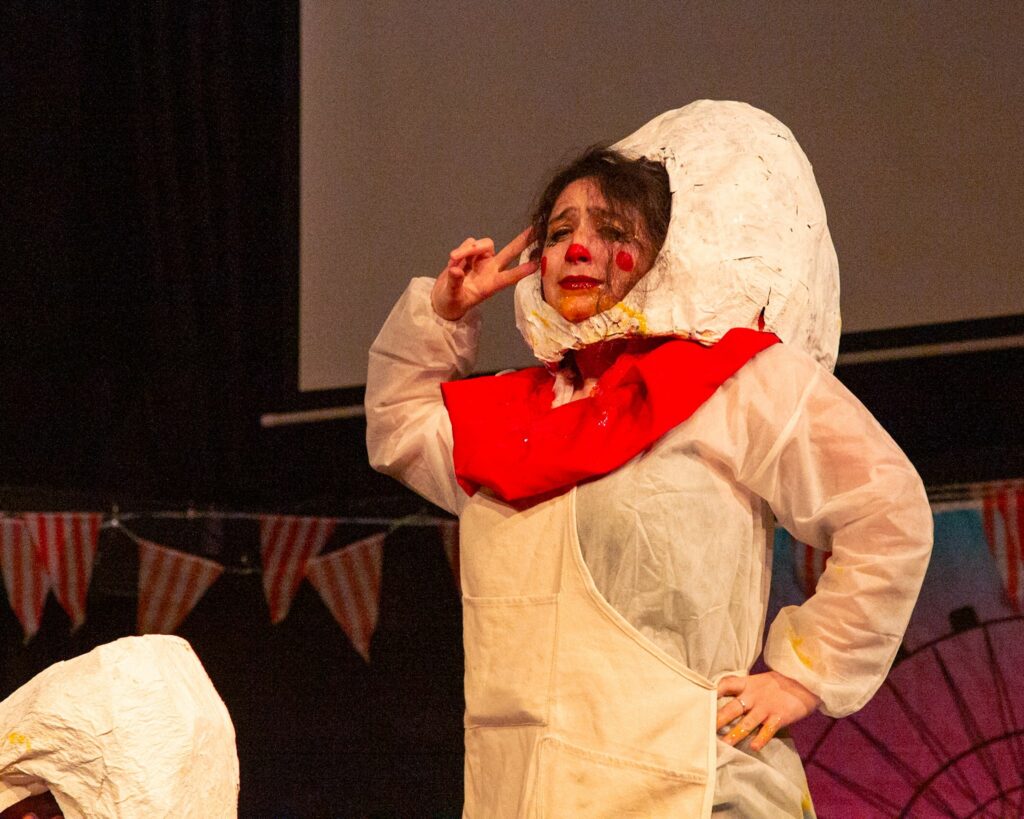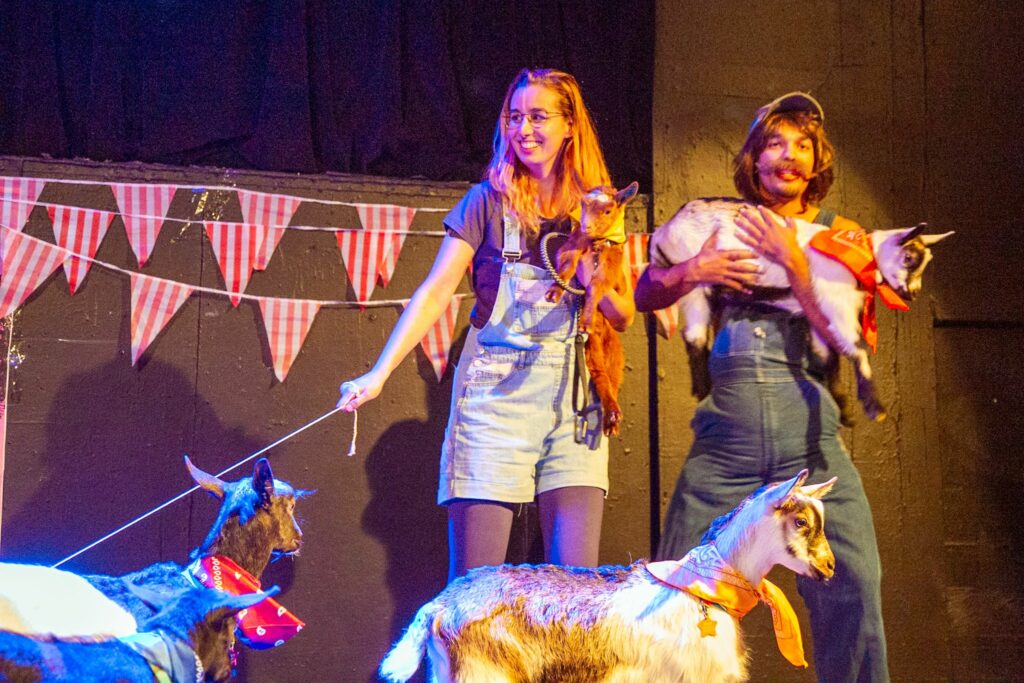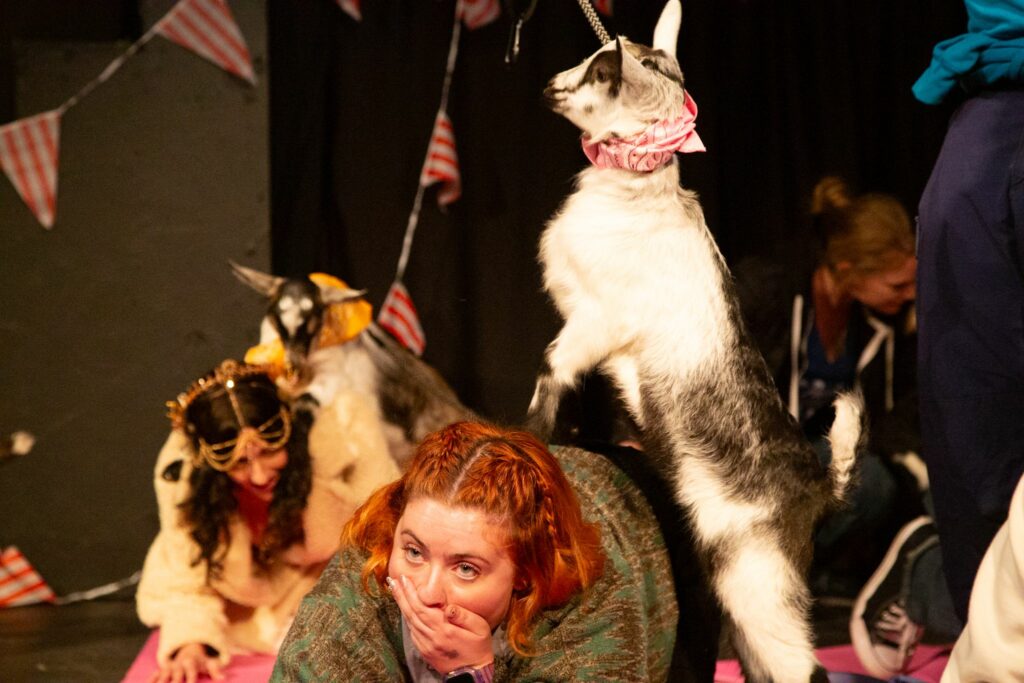Those That Are Fools: At Clownchella

Photograph by Sarah Shtern.
“Well, God give them wisdom that have it; and those that are fools, let them use their talents.”
—Feste the Clown, Twelfth Night, William Shakespeare
Walking up to the Elysian Theater, a small club off the 5 at the foot of Elysian Heights in Los Angeles, I thought I was hallucinating when I saw a dozen goats under the bright white light of the marquee, and for every goat a clown. Everyone was fawning over the short-haired creatures. Some had two little bald spots on their heads instead of horns, which, I later learned, is where the hot irons get applied for disbudding.
The Elysian was hosting Clownchella, an event happening the week before Coachella. Maybe it goes without saying: these events bear virtually no relation to each other. Coachella is a sprawling music and art festival of spoon-fed nostalgia, snakeskin pants, and sensorially shattering spectacle held on the grounds of a polo club, brought to you by sponsors like American Express, Coca-Cola, BMW, et cetera, and which costs (at least) $510 plus accommodations. Clownchella was a one-night clown festival with five acts that cost sixteen bucks.
At Clownchella, I expected circus-variety clowns, red noses and big shoes. I had figured that the history of clowning had reached its terminus; from ancient Greek mimes to commedia dell’arte, Charlie Chaplin to Bozo to Krusty (my personal favorite). The clowns most relevant to our times seem to be the old-fashioned scary ones, the Jokers and the Pennywises. But I’d heard that Los Angeles has a diverse and burgeoning clown scene that’s innovating the form. Independent teachers are developing their own clown pedagogy, nurturing a new generation of performers and borrowing from European clowns, who, apparently, are way ahead of the curve. This summer, Hannah Levin, the host of Clownchella, and some other LA clowns are traveling to Étampes, France, to study with the French clown and pedagogue Philippe Gaulier, who for the past fifty years has taught clowning using methods like mask play, Greek tragedy, and the study of Chekhov, all with the goal of finding the clown within. The clowns here take silliness very seriously. Standing outside the Elysian, I watched as the goats jumped around and let out cute little bleats.
A woman with magenta-colored hair, Scout, who runs Party Goats LA, told me they were rescues, mostly Oberhaslis, a breed of dairy goat developed in Switzerland, except for the one Nigerian dwarf goat in attendance. Scout and her crew bring the goats to children’s parties and senior homes, do goat hikes, and are planning to start providing brush clearance services for wildfire prevention. “Goats and people have had a relationship for over ten thousand years,” she said. “They were the second animal domesticated after dogs. And no matter what culture your ancestors are from or where you come from—” In the middle of her sentence I glanced up and saw a tallish man with a bald crown and short white hair on the sides. He wore a custom letterman jacket with the words clown boss on the back in big red fuzzy letters. I’d heard about Clown Boss, a.k.a. Chad Damiani. I’d heard that this was a clown you didn’t want to cross. Indeed, despite the tightly packed crowd, a perimeter of personal space was allotted to him, as for a capo at a wedding, or funeral.
All the animals filed into the theater’s foyer. Near the front desk, I introduced myself to Sethward, who is known for absurdist performances in homemade animal costumes and several appearances on America’s Got Talent. He had a giant mustache and a somewhat odd manner of speaking. I saw the performers cramming through the door leading to the green room and decided to sneak in. I’d expected to see people putting on big red wigs and blowing balloon animals and straightening their dunce caps, but instead it was mostly full of goats. All the performers were dressed in normal clothes. What kind of clown show was this gonna be? I cradled a baby goat in my arms, gave it a kiss, and went back to the theater’s foyer.

Photograph by Sarah Shtern.
I saw Clown Boss standing near the concession stand and walked over. He had a neat white beard and somewhat muscular build, and watched me as I approached. I was struck by his eyes, nearly jet black, a mix of sadness and kindness swimming in them. I scanned his torso for a squirting flower or spinning bow tie. He was pleasant and friendly. I asked him what a clown is. “A clown presents some sort of game, or method of play, that the audience can participate in,” he said. “And normally, it’s really dumb. Because that just adds to the pleasure.”
Damiani used to be a pro-wrestling announcer, then a successful six-figure-earning screenwriter. After his partner died from pancreatic cancer, he asked himself what he was doing with his life. Damiani started to clown about thirteen years ago and has become a sort of clown guru, hosting numerous intensives and workshops every week. He has a podcast about clown. (The clowns I spoke with used the word clown in this way, as an abstract noun, a state of being, rather than a common noun or verb.)
Inside the theater, I sat in the second row. In the marketing for Clownchella the crowd was encouraged to dress like they were going to Coachella. One woman donned a low-cut silvery dress and sparkly head jewelry, another was dressed in all leopard print, and there were two high-glam punks, but these may have just been their Thursday fits. The hosts were Hannah Levin, a clown and licensed social care worker who curated Clownchella, and Deshawn Ball, a former Marine who, with Jamonte Williams, runs a group called Clowns of Color, whose routines have included Oompa Loompas demanding reparations and French chefs wearing jockstraps. Levin and Ball were dressed like farmers in overalls. As they did their opening bit—dispersing “golden tickets” for goat yoga—bubbles magically appeared and floated through the crowd. Then the goats were brought out to Beyoncé’s “Texas Hold ’Em” and there was much dancing and hooting.
The closest thing to circus clowns came during the opening act. The Egg Heads wore giant papier-mâché eggshells on their heads, red ruff collars, red circles painted on their cheeks, and red painted noses. The two of them fell over each other and committed minor humiliations. Yellow yolk dripped down their chins as they gave dejected downward smiles. The next act was a contrast: Best Actress, a three-clown troupe who were dressed like normal. These scaramouches posed as festival concierges and took the crowd’s drink orders. Pretending to hear “breast milk,” one of the clowns took out her left breast and started pumping.
This reminded me of something else that Damiani said: “We don’t have permission to be dumb in our lives. We’re told that if we’re dumb we’ll lose our jobs, or that we’re bad parents, or bad partners. Here, we can let go and do something foolish.” The clown John Bradford appeared at the top of the slope leading down into the theater. He had long blond hair covered by a red skull cap, a houndstooth cardigan, and very tight khakis. He wore two skis, and with agonizing effort he slid down the incline, nothing to lubricate his descent, ski poles impotently tapping the floor. After being assisted onto the stage he grunted as he cross-countried the two yards to the stage’s center. His back to the audience, silent, he turned his face around coyly, showing off his perky ass. This went on for some number of minutes. And then it kept going, the laughs gradually diminishing as the gag went on until the awkward lack of laughter caused laughter anew.
The psychology of clowning is complicated. Or is it totally simple? Rachel Troy, who works as a therapist, was originally doing more Groundlings-type sketch characters. She got into clowning about two years ago, after taking the Idiot Workshop, a class started by John Gilkey in 2012 that had also inspired Damiani to pursue it more seriously. “Clown seems to be about paradoxes,” Troy said, “and about flipping things on their head completely. Making you think differently. In a lot of the work that I see [in Los Angeles], there is an intensity.”
For her set at Clownchella, Troy held a comically oversize wire hanger around her head, the prop a stand-in for her character. Wire Hanger spoke in a childlike quiver, described her withered self-confidence and shriveled drive. “I never let myself dream,” she said, pathetically. Wire Hanger couldn’t hold anything up, couldn’t bear the weight of even the slightest gown. “Just came out of the closet,” she said to pained chuckles. This bouffon performance was cringey, pitiful, and mocking of power. “I couldn’t get straight enough,” Wire Hanger said. “Rachel flagged down a cop and, well, he got the job done. I’ll tell ya, nothing shakes your confidence than knowing you’re more useless than a cop!” In the end, Wire Hanger triumphed, transformed into Joan Crawford from Mommie Dearest (who hates wire hangers) and put on a heavy luxurious fur coat.

Photograph by Sarah Shtern.
Finally the theater dimmed and two blazing beams of light shot into the room from the entrance. Clown Boss appeared in a red turtleneck, a motley muumuu, and red sunglasses. He was leading the troupe FLWLS (Flawless), so trailing behind him were four performers, Deidre Lee, Nalini Sharma, Caroline Cummings, and Emily Shankman. “What you’re going to see tonight,” he said, using two flashlights as spotlights on the performers, “are these four clowns taking on the ultimate challenge—they are going to do a better show… than goats can.” The performers were dressed like goat-mime hybrids, black pants and white tops, fake horns, a conceptual smudge of white face paint. Damiani coached the performers—a sort of Max Bialystock from The Producers—critiquing their movements and sometimes singing small praises. “Show me courage!—that’s good Diedre!” The goat-mimes pined for his approval and also mischievously disobeyed. At one point he encouraged the performers by saying “The press is here tonight!” (me) and I felt the thrill of recognition, or a thinly veiled threat. Damiani told the sound tech to play Tchaikovsky’s “Waltz of the Flowers” but Johann Strauss II’s “The Blue Danube” got played by mistake. The performers crawled and bucked, chewed one another’s hair, recited Hamlet’s “To be, or not to be” speech, and climbed the crowd like they were cliffsides.
The show seemed over. But then, with an awful shriek, a large and terrifying creature tumbled out from a small door under the stage’s staircase. Sethward wore a monstrous goat costume. On welded stilts he stood about eight feet tall. He let out piercing baas and begged the audience for help as he rose up on his grotesque armature, spittle on his fake goatee, then fell backward on his ass over and over, abjectly. He stood over two people in the first row and leaned toward me. Sethward’s performance was a punishing slapstick, a tremendous feat of self-inflicted violence that rendered brutally clear the sometimes-thin line between humor and horror. (One influential clown and teacher in Los Angeles is Red Bastard, whose creepy bouffon act includes an all-red costume and white face paint. He likes to get audience members to disclose their secrets, and also call their mothers to apologize.)

Photograph by Sarah Shtern.
The night ended with a final session of goat yoga; there’d been three or maybe four sessions throughout. The whole audience got on the stage, as did all the clowns. The “yoga instructor” carnival-barked her orders—Downward dog! Child’s pose!—as the goats jumped on people’s backs and ran around, chewed on people’s hair and pissed on the stage as crew members chased them to sop it up with blue towels. Watching the scene from my seat, I saw that some audience members’ faces were caked in their own clown paint.
The yoga element seemed oddly fitting. Clowning is not therapy, but talking with all these Los Angeles clowns, there’s a clear connection to wellness, to self-actualization through supportive, loving community. Deshawn Bell told me, “Through clown, I learned how to break that mold that I created for myself, or that society had created for me.”
Before the show, I’d been reading about the heyoka, a sacred clown in Sioux society, a fool figure who begs for food during times of plenty, laughs during tragedy, becomes an agent of chaos when peace prevails. Sure, laughing helps the pain, but I did find myself craving a little more from Clownchella. Maybe I wanted something closer to the sacred clown, or to glimpse a more radical clown underground, a place where the jester’s privilege is invoked to eviscerate those who value power over beauty, money over truth, property over life.
Or was I just not letting myself be dumb enough?
“Goats can make you laugh, but can they make you cry?” Clown Boss joked during FLWL’s set at Clownchella. “Can they make you think? Can they make you care?”
Rob Goyanes is a writer and editor from Miami, Florida. He lives in Los Angeles.
